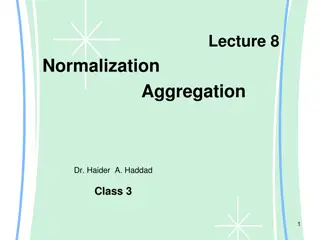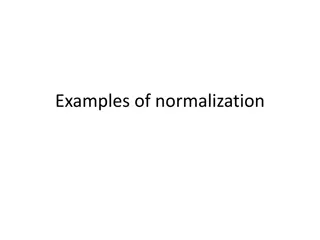Understanding Database Normalization and Functional Dependencies
Database normalization is a crucial process that aims to improve database design by organizing data into higher forms of normality. This helps in reducing redundancy and ensuring data integrity. Functional dependencies play a key role in defining relationships between attributes in a database. By understanding these concepts, one can enhance data organization and management efficiency.
Download Presentation

Please find below an Image/Link to download the presentation.
The content on the website is provided AS IS for your information and personal use only. It may not be sold, licensed, or shared on other websites without obtaining consent from the author. Download presentation by click this link. If you encounter any issues during the download, it is possible that the publisher has removed the file from their server.
E N D
Presentation Transcript
Department of Master of Computer Applications St. Joseph s College (Autonomous) Tiruchirappalli - 2 I Semester Semester NORMALIZATION MCA Programme Programme Course Code Course Code Course Course Database Systems 21PCA1301 Dr. S. Albert Rabara Associate Professor
Normalization Normalizationis a process that improves a database design by generating relations that are of higher normal forms. The objective of normalization: to create relations where every dependency is on the key, the whole key, and nothing but the key . 2
Normalization There is a sequence to normal forms: 1NF is considered the weakest, 2NF is stronger than 1NF, 3NF is stronger than 2NF, and BCNF is considered the strongest 3
Normalization 1NF a relation in BCNF, is also in 3NF 2NF a relation in 3NF is also in 2NF 3NF a relation in 2NF is also in 1NF BCNF 4
Normalization The benefit of higher normal forms is that update semantics for the affected data are simplified. This means that applications required to maintain the database are simpler. A design that has a lower normal form than another design has more redundancy. Uncontrolled redundancy can lead to data integrity problems. The concept of functional dependency 5
Functional Dependencies Functional Dependencies We say an attribute, B, has a functional dependency on another attribute, A, if for any two records, which have the same value for A, then the values for B in these two records must be the same. We illustrate this as: A B Example: Suppose we keep track of employee email addresses, and we only track one email address for each employee. Suppose each employee is identified by their unique employee number. We say there is a functional dependency of email address on employee number: employee number email address 6
Functional Dependencies EmpNum 123 456 555 633 787 EmpEmail jdoe@abc.com psmith@abc.com alee1@abc.com pdoe@abc.com alee2@abc.com EmpFname John Peter Alan Peter Alan EmpLname Doe Smith Lee Doe Lee If EmpNum is the Primary Key then the FDs: EmpNum EmpEmail EmpNum EmpFname EmpNum EmpLname . 7
Functional Dependencies EmpNum EmpEmail EmpNum EmpFname EmpNum EmpLname 3 different ways you might see FDs depicted EmpEmail EmpFname EmpNum EmpLname EmpNum EmpEmail EmpFname EmpLname 8
Determinant Functional Dependency EmpNum EmpEmail Attribute on the LHS is known as the determinant EmpNum is a determinant of EmpEmail 9
Transitive dependency Consider attributes A, B, and C, and where A B and B C. Functional dependencies are transitive, which means that we also have the functional dependency A C We say that C is transitively dependent on A through B. 10
Transitive dependency EmpNum DeptNum EmpNum EmpEmail DeptNum DeptName DeptNum DeptName EmpNum EmpEmail DeptNum DeptName DeptName is transitively dependent on EmpNum via DeptNum EmpNum DeptName 11
Partial dependency A partial dependency exists when an attribute B is functionally dependent on an attribute A, and A is a component of a multipart candidate key. InvNum LineNum Qty InvDate Candidate keys: {InvNum, LineNum} InvDate is partially dependent on {InvNum, LineNum} as InvNum is a determinant of InvDate and InvNum is part of a candidate key 12
Database Tables and Normalization The Need for Normalization Case of a Construction Company Building project -- Project number, Name, Employees assigned to the project. Employee -- Employee number, Name, Job classification The company charges its clients by billing the hours spent on each project. The hourly billing rate is dependent on the employee s position.
Database Tables and Normalization Dependency Diagram The primary key components are bold, underlined, and shaded in a different color. The arrows above entities indicate all desirable dependencies, i.e., dependencies that are based on PK. The arrows below the dependency diagram indicate less desirable dependencies -- partial dependencies and transitive dependencies.
Database Tables and Normalization 1NF Definition The term first normal form (1NF) describes the tabular format in which: All the key attributes are defined. There are no repeating groups in the table. All attributes are dependent on the primary key.
Database Tables and Normalization Conversion to Second Normal Form Starting with the 1NF format, the database can be converted into the 2NF format by Writing each key component on a separate line, and then writing the original key on the last line and Writing the dependent attributes after each new key. PROJECT (PROJ_NUM, PROJ_NAME) EMPLOYEE (EMP_NUM, EMP_NAME, JOB_CLASS, CHG_HOUR) ASSIGN (PROJ_NUM, EMP_NUM, HOURS)
Database Tables and Normalization 2NF Definition A table is in 2NF if: It is in 1NF and It includes no partial dependencies; that is, no attribute is dependent on only a portion of the primary key. (It is still possible for a table in 2NF to exhibit transitive dependency; that is, one or more attributes may be functionally dependent on nonkey attributes.)
Database Tables and Normalization Conversion to Third Normal Form Create a separate table with attributes in a transitive functional dependence relationship. PROJECT (PROJ_NUM, PROJ_NAME) ASSIGN (PROJ_NUM, EMP_NUM, HOURS) EMPLOYEE (EMP_NUM, EMP_NAME, JOB_CLASS) JOB (JOB_CLASS, CHG_HOUR)
Database Tables and Normalization 3NF Definition A table is in 3NF if: It is in 2NF and It contains no transitive dependencies.
Database Tables and Normalization Boyce-Codd Normal Form (BCNF) A table is in Boyce-Codd normal form (BCNF) if every determinant in the table is a candidate key. (A determinant is any attribute whose value determines other values with a row.) If a table contains only one candidate key, the 3NF and the BCNF are equivalent. BCNF is a special case of 3NF.
Database Tables and Normalization BCNF Definition A table is in BCNF if every determinant in that table is a candidate key. If a table contains only one candidate key, 3NF and BCNF are equivalent.
First Normal Form First Normal Form A relation is in 1NF if all values stored in the relation are single-valued and atomic. 1NF places restrictions on the structure of relations. Values must be simple. 23
Second Normal Form A relation is in 2NF if it is in 1NF, and every non-key attribute is fully dependent on each candidate key. 2NF (and 3NF) both involve the concepts of key and non-key attributes. A key attribute is any attribute that is part of a key; any attribute that is not a key attribute, is a non-key attribute. Relations that are not in BCNF have data redundancies A relation in 2NF will not have any partial dependencies 24
Second Normal Form Consider this InvLine table (in 1NF): InvNum LineNum ProdNum Qty InvDate InvNum, LineNum ProdNum, Qty There are two candidate keys. Qty is the only non- key attribute, and it is dependent on InvNum InvNum InvDate Since there is a determinant that is not a candidate key, InvLine is not BCNF InvLine is only in 1NF InvLine is not 2NF since there is a partial dependency of InvDate on InvNum 25
Second Normal Form InvLine InvNum The above relation has redundancies: the invoice date is repeated on each invoice line. LineNum ProdNum Qty InvDate We can improve the database by decomposing the relation into two relations: InvNum LineNum ProdNum Qty InvNum InvDate 26
2NF, but not in 3NF, nor in BCNF: EmployeeDept Ename Ssn Bdate Address Dnumber Dname since Dnumber is not a candidate key and we have: Dnumber Dname. 28
Third Normal Form A relation is in 3NF if the relation is in 1NF and all determinants of non-key attributes are candidate keys That is, for any functional dependency: X Y, where Y is a non-key attribute (or a set of non-key attributes), X is a candidate key. This definition of 3NF differs from BCNF only in the specification of non-key attributes - 3NF is weaker than BCNF. (BCNF requires all determinants to be candidate keys.) A relation in 3NF will not have any transitive dependencies of non-key attribute on a candidate key through another non-key attribute. 29
Third Normal Form Consider this Employee relation Candidate keys are? EmpNum EmpName DeptNum DeptName EmpName, DeptNum, and DeptName are non-key attributes. DeptNum determines DeptName, a non-key attribute, and DeptNum is not a candidate key. Is the relation in 3NF? no Is the relation in BCNF? no Is the relation in 2NF? yes 31
The Decomposition of a Table Structure to Meet BCNF Requirements
Third Normal Form EmpNum EmpName DeptNum DeptName We correct the situation by decomposing the original relation into two 3NF relations. Note the decomposition is lossless. EmpNum EmpName DeptNum DeptNum DeptName Verify these two relations are in 3NF. 33























